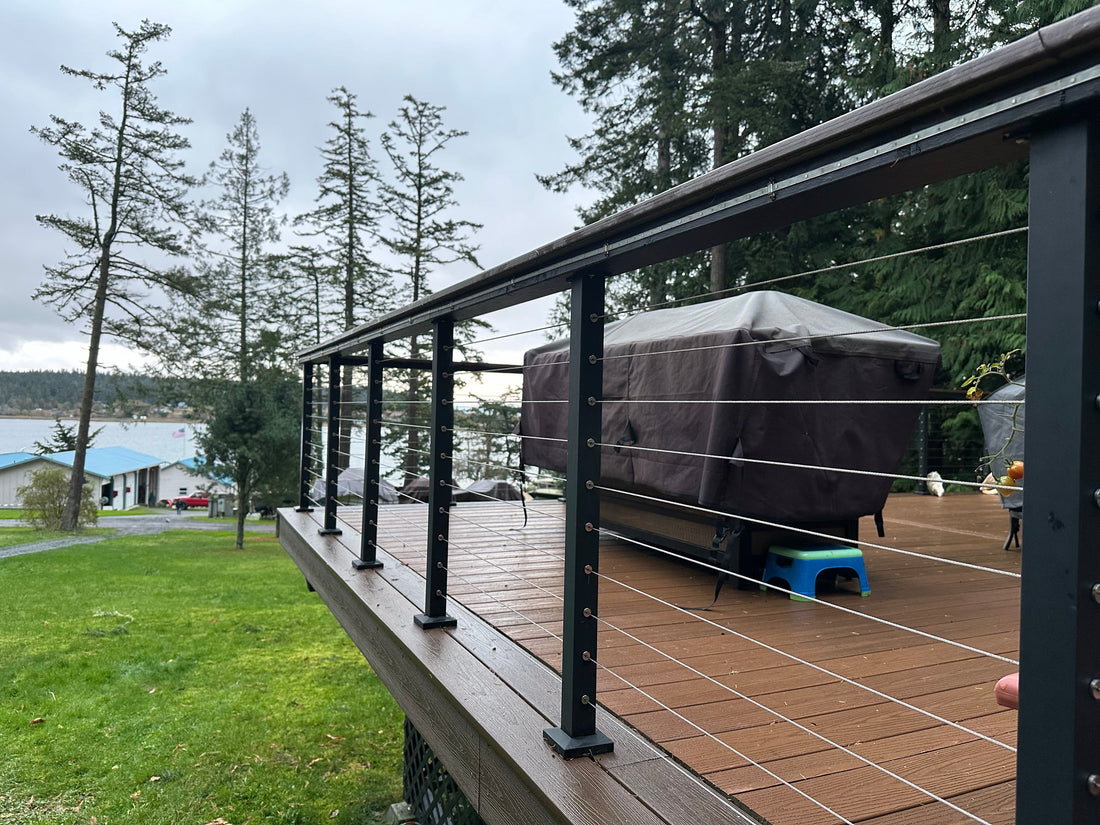A fresh deck feels incomplete without the right guard. The best deck railing ideas protect your family, frame the view, and match your home’s lines. Use this 2025 guide to compare styles, materials, and upkeep. You will see what fits your climate, budget, and maintenance routine, then choose with confidence.

Quick Comparison Sheet
Scan the six deck railing ideas below, then jump to the section that matches your goals.
| Idea | View openness | Maintenance | Privacy | Wind suitability | DIY difficulty |
| 1. Wood + Stainless Cable | High | Medium | Low | High | Medium–High |
| 2. Black Aluminum + Thin Pickets | Medium | Low | Medium | High | Medium |
| 3. Aluminum Frame + Glass Infill | Very High | Medium–High | Low | Medium | Medium |
| 4. Horizontal Metal Bars or Rods | Medium–High | Low | Low | High | Medium |
| 5. Two-Tone Composite Railings | Medium | Low | Medium | High | Medium |
| 6. Integrated LED Lighting | Works with 1–5 | Low–Medium | Low | High | Medium |
Note: Idea 6 adds lighting to any of the other deck railing ideas. It is a design and safety upgrade that layers on top of your chosen style.
Mix Wood and Cable for a Modern Deck Railing
Warm wood pairs beautifully with clean, industrial stainless steel cables. This combination achieves a relaxed modern aesthetic that preserves open sightlines, making it a top contender among modern deck railing ideas. Homeowners love how the wood posts and matching top rail add natural texture and warmth, while the stainless cable infill keeps the horizon clear and the deck feeling airy. This versatile style is equally at home on cabins, lake houses, and contemporary remodels.
Key Planning & Installation Considerations
This system's elegance relies on careful planning to manage the high tension required by cable infill.
- Structural Integrity: Cable railings are tension-based systems, meaning end and corner posts bear significant loads. These posts must be robustly reinforced, often with solid blocking inside the deck frame, and use high-quality structural hardware. This is not an area to cut corners.
- Code Compliance & Spacing: To pass inspection, openings must prevent a 4-inch sphere from passing through. For horizontal cables, this means precise spacing, typically between 3 and 3⅛ inches, to account for potential cable sag. Always verify with your local code authority.
- Material Selection for Durability: In coastal areas, near pools, or in humid climates, specifying Type 316 stainless steel for all cables and hardware is crucial. This marine-grade steel offers superior corrosion resistance compared to the more common 304 grade, preventing rust and ensuring longevity.


Go Sleek with Black Aluminum and Thin Pickets
Black aluminum railings bring a bold, architectural feel to a deck. The crisp lines of slim vertical pickets create a sharp contrast against wood or composite decking, offering a tailored edge that complements traditional, transitional, and modern homes alike. The appeal lies in its powerful aesthetic and practicality; the powder-coated aluminum is lightweight, strong, and exceptionally low-maintenance. This makes it an easy choice to pair with black window frames, light fixtures, and other dark exterior accents for a cohesive look. For a clean, minimalist style, explore the 9 Best Black Aluminum Cable Railings to find the perfect fit for your home.
Key Planning & Installation Considerations
Success with aluminum railings comes from attention to detail in spacing and component selection.
- Picket Spacing and Code: Adhering to local code is paramount. Most jurisdictions use the "4-inch sphere test," meaning the gap between pickets cannot allow a 4-inch sphere to pass through. Plan your layout to ensure this standard is met everywhere, including on stairs.
- Visual Weight and Cohesion: On smaller decks, using slim-profile posts can significantly reduce the railing's visual weight, making the space feel larger. For a polished, unified appearance, always use matching gate hardware for any access points near stairs or the yard.
- Fastener Choice: Use the manufacturer-recommended fasteners. Using the wrong type can lead to galvanic corrosion, especially where the aluminum contacts other metals or pressure-treated wood, compromising the coating and structural integrity over time.

Add a Modern Touch with Aluminum Frames and Glass Infill
When the view is the main attraction, glass panel railings offer a nearly invisible, sophisticated barrier. Set within narrow aluminum frames, the glass keeps sightlines completely unobstructed, allowing the deck to feel calm, contemporary, and seamlessly connected to the surrounding landscape—be it water, woods, or city lights. Beyond the stunning views, homeowners appreciate that glass panels also provide excellent wind protection without the visual bulk of traditional pickets, pairing perfectly with large sliding glass doors and modern flat rooflines.
Key Planning & Installation Considerations
Planning for glass railings centers on safety specifications and practical, long-term use.
- Glass Specification and Safety: The choice of glass is a critical safety decision. Standard panels are typically 6mm to 10mm thick tempered glass. However, for wider spans, high-wind zones, or elevated decks, building codes may require thicker panels or laminated glass (which holds together if shattered) for enhanced safety.
- Comfort and Durability: While frameless systems exist, adding a slim, continuous top rail is highly recommended. It not only provides a comfortable and secure place to rest hands but also protects the top edge of the glass panels from chipping and adds significant rigidity to the overall system.
- Drainage and Cleaning: Think ahead about maintenance. Ensure there are proper drainage pathways at the base of the glass panels to prevent water from pooling. In areas with heavy pollen, dust, or hard water, planning for easy cleaning access will make upkeep far less of a chore.

Achieve an Industrial Look with Horizontal Metal Bars
For a confident, urban aesthetic, horizontal metal bars or rods are an excellent choice. The strong, clean lines create a distinct rhythm on long railing runs and echo the look of modern siding and window grids. Homeowners are drawn to this style for its durable, contemporary profile that maintains consistent alignment over time with less adjustment than other infill types. It coordinates effortlessly with minimalist outdoor furniture and black architectural accents, creating a sharp, industrial-chic space.
Key Planning & Installation Considerations
While visually striking, horizontal railings require careful attention to local building codes and structural support.
- Code Compliance Alert: This is the most critical step. Some jurisdictions have restricted or banned horizontal "ladder-like" railings due to concerns about climbability, especially in single-family homes. You must confirm with your local building authority that this style is permissible before committing to it. If approved, it must still meet the 4-inch opening rule between bars.
- Structural Rigidity: Horizontal bars, especially over wide spans between posts, can be prone to deflection or bending if pushed on. To prevent this, it's essential to add intermediate vertical supports (balusters) or use heavier-gauge, thicker rods that resist flexing.
- Top Rail Comfort and Design: The top rail's profile significantly impacts daily use. Since the infill is hard metal, choose a comfortable top rail, such as a flat composite board or a smooth, graspable wood profile, to provide a pleasant and secure handrest.
Create Contrast with Two-Tone Composite Railings
Two-tone composite systems use color strategically to highlight a deck's form and transitions. By pairing a dark post with a light top rail, or vice-versa, you can create a custom look that mirrors your home’s trim, siding, or roofing colors. Homeowners appreciate the vast array of color options and the consistent, durable factory finishes that require very little routine care. This style delivers a unified, high-end "built-in" appearance that is versatile enough to suit a wide range of exteriors, from classic to contemporary.
Key Planning & Installation Considerations
The key to a successful two-tone design lies in meticulous color mapping and ensuring code compliance from a single manufacturer's system.
- Strategic Color Mapping: Before ordering materials, create a clear plan or sketch. Decide precisely where each color will go: posts, top rail, bottom rail, and balusters (infill). For a cohesive design, consider repeating the darker accent color on the deck's stair stringers or fascia board to tie the whole look together.
- System Integrity and Code: It's best to use components from a single manufacturer's system. Mixing and matching parts from different brands can void warranties and may not meet the necessary structural testing requirements. Always verify that the final assembled height of your chosen components will meet your local guardrail height requirements (typically 36 or 42 inches).
- Follow Manufacturer Guidelines: Composite materials expand and contract with temperature changes. To protect the finish, warranty, and structural integrity, it is crucial to follow the manufacturer’s specific fastener and gapping guidelines during installation.
Light Up Your Deck with Integrated LED Railing
Integrated lighting is a transformative feature that turns a deck into a functional and inviting evening space. By embedding discreet, low-voltage LEDs into the top rail, post caps, or under the handrail, you can enhance safety and dramatically extend your outdoor hours. The result is a warm, even glow that keeps steps, landings, and corners safely visible without the harsh glare of traditional floodlights. This creates a sophisticated ambiance perfect for quiet gatherings and late dinners, all while keeping the wiring hidden to preserve the deck's clean, modern lines.
Key Planning & Installation Considerations
Adding lighting requires early, detailed planning before the railing is even installed. It is not easily retrofitted.
- Early-Stage Wiring Plan: This is the most critical step. You must decide at the beginning of your project where the low-voltage transformer will be located, how the power will run to the deck, and the precise path the wiring will take through or along posts and rails. This often involves drilling access holes before assembly.
- Light Quality and Control: Match the light's color temperature to your home's other exterior fixtures, typically a warm white in the 2700K to 3000K range, for a cohesive look. For ultimate flexibility, incorporate a dimmer switch to adjust the mood from functional brightness to a soft glow, and a timer for automated, energy-saving operation.
- Component and System Choice: Select a lighting system that is fully integrated with your chosen railing brand. This ensures a proper fit for components like post caps and under-rail light strips. It's also wise to have a few spare parts, like lens covers or caps, on hand for any future repairs.

Smart Rules That Keep Every Idea Code-Ready
Trends are exciting, but guards must pass inspection. These checks make any of the deck railing ideas safer and easier to approve.
- Height: Many single-family decks require 36 inches. Many multifamily or higher decks require 42 inches. Confirm with your local office.
- Openings: Design infill so a 4-inch sphere cannot pass. Some stair or intermediate zones allow 4⅜ inches as an exception. Ask your authority having jurisdiction and plan a small margin for seasonal movement.
- Loads: Expect about 200 pounds applied at the top rail at any point and a uniform line load of about 50 pounds per foot. Size posts, top rail, bases, and anchors to match those expectations.
Pick a 2025-Ready Railing That Fits Your Home
Great deck railing ideas do more than look good. The right choice guides movement, protects edges, and frames the view so the deck feels like an outdoor room. Start with climate and code, choose a material that fits your maintenance plan, then select the infill that feels right in your hand and in photos. Tape a clear rail line, choose surface or fascia mounting to suit your structure, commit to your preferred idea, and move from layout to materials today.
FAQs
Q1. How do I obtain permits and HOA approval for new deck railings?
Make a basic submittal package: put in a scaled plan with dimensions, plans with guard height, details that comply with the 4-inch rule, anchor/spec sheets, and wind and snow exposure information. You should also provide finish samples. Describe the duration of the review and submitting documents via email to your AHJ/HOA. Beginning with a planner early can expedite approval and save you from costly redraws.
Q2. In what manner do you best prevent rust when welding or bolting steel onto weather-treated wood?
Utilize 316 stainless steel near the shore and isolate other metals from each other: utilize EPDM or nylon gaskets, plastic sleeves, or isolation pads between stainless fasteners and aluminum posts. When fastening to wood that has been treated with ACQ or MCQ, utilize stainless or hot-dip galvanized anchors that perform well. Apply anti-seize to stainless threads to prevent galling and inspect joints annually.
Q3. How can I learn about materials and price quickly prior to requesting quotes?
Measure deck edges for total linear feet. Assume posts about every 4 feet plus each corner and gate. Count end posts, corners, and intermediates separately. Estimate cable or bar rows from rail height and target spacing, add 10% waste. Flag extras: gates, stairs, lighting, core drilling, and membrane repairs.





